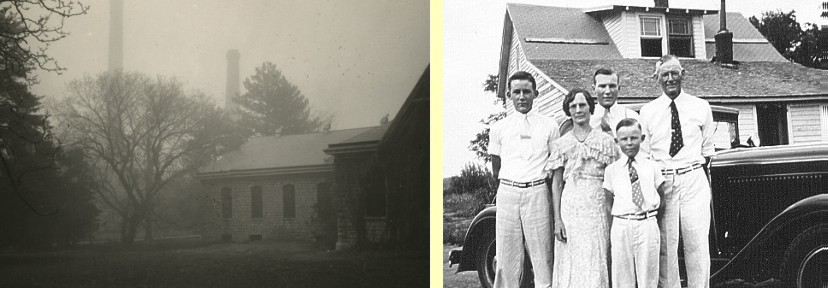Kansas Snapshots by Gloria Freeland - April 24, 2015
"I wonder how the folks kept going"
We got some nice rain last week. It wasn't much, but it was enough to bring out the lush spring green in the Flint
Hills I love so much.
But farmers are worried. We didn't get our usual snowfall this winter. An April 14 headline on an article in the
Manhattan Mercury read, "Drought takes toll on winter wheat in western Kansas." The National Agricultural Statistics
Service said 28 percent is in poor to very poor condition, about 44 percent is fair. Only two percent is excellent.
The problem isn't just in Kansas either. Another article was titled "Drought devastating California farms, drying up
jobs." That state has had much drought in recent years, but this one appears to be developing into one of the worst.
The mountains contain only about six percent of their average annual snowpack. Gov. Jerry Brown mandated non-agricultural
water restrictions.
Eighty years ago on that same date, morning in Kansas dawned clear. No one guessed it would come to be called Black
Sunday. After weeks of dust storms had destroyed crops and carried topsoil away, people were glad to see the sun. Many
cleaned their homes from top to bottom, went to church and had picnics.
But in mid-afternoon, the temperature dropped sharply and, within minutes, an enormous miles-wide black cloud swept
through Oklahoma and Texas and affected large parts of Colorado, Kansas, and other states. While the Freeland farm in
Marion County, Kansas wasn't in the area most affected, Uncle Stan, who was 12 at the time, recalls the day.
"I can't remember if we got to church that Sunday. I think we did because it was an unusually nice day and clear
and no wind. It was one of those days that didn't happen very often then. I was thinking of riding our saddle horse to
visit Leroy Brenzikofer after lunch, but suddenly the sky in the west started to get dark like we might get some rain.
Then the wind picked up not too bad, but it wasn't long before the sun disappeared and it got pretty dark. It seemed
strange it wasn't blowing hard enough in our area to make it that dark. The dust was blowing in from Colorado. I think
we had worse days for a blowing wind and dust from our fields. I think it was said the dust that day traveled as far as
the east coast."
But it wasn't just that one day that was bad. The dust storms had begun in the early 1930s and continued into the
latter part of the decade. My parents and others who lived through that period called it the "Dirty �30s" - and with
good reason. Mom, now 91, said her mother put wet tea towels and sheets around the window and door frames to keep dust
from entering their Morris County, Kansas farmhouse. She recalled turning plates, cups and bowls upside down until
time to eat so the family wouldn't have grit mixed in their food.
Her sister Edith, almost 95, said:
"...We were mortgaged to the hilt and the weather with droughts, dust storms and crop-eating locusts made living
hard. We even lost our trees, so [we] often had to gather dried cow chips in the pasture to keep our stoves
going ..."
Stan recalled how difficult it was on their farm.
"I remember one day when Grandpa planted alfalfa in the field west of the house and the next day the wind blew a
gale and the seed disappeared... I remember more about �36. To me that was the year of the grasshopper plague when they
ate bark off the trees and fence posts."
On particularly hot nights, Stan and Dad slept outside on a flatbed trailer south of the milk house to try to keep
cool. During the day, they covered it with a tarpaulin to keep the dust off.
"... [We had] 120 degree temps day after day, even when the wind would switch around to the north ... but it was
just as hot and brought dust into the house when a car would go by. Mom would do everything to keep the dust out, but
it was an impossible task. On top of that, all of the cooking was done on a wood range. It is a miracle she lived to
see better days."
According to livinghistoryfarm.org, in 1932, 14 dust storms were recorded on the Plains. In 1933, there were 38. By
1934, it was estimated that 100 million acres of farmland had lost most of its topsoil to winds.
The day after Black Sunday, reporter Robert Geiger wrote, "Residents of the southwestern dust bowl marked up another
black duster today�" The term stuck and has been used ever since. Ken Burns' November 2012 two-part documentary was
called "The Dust Bowl."
Timothy Egan, author of "The Worst Hard Time," documented stories about Dust Bowl survivors. During a visit to
Manhattan in November 2007, he spoke about the people he interviewed.
"Their endurance and strength of character blew me away. ... It is one thing to read a diary. It's another to
look into another's face. This is how history should be told - not as a sepia-toned distant thing, but as individual
stories."
The resilience of the people inspires us today, 80 years later. Stan, now 92, commenting about Grandma and Grandpa,
said, "There were a lot of disappointing times then. I often wonder how the folks kept going ..."
They and many others did keep going. And this year the Flint Hills are again a beautiful spring green.
Yet there is cause for concern.
